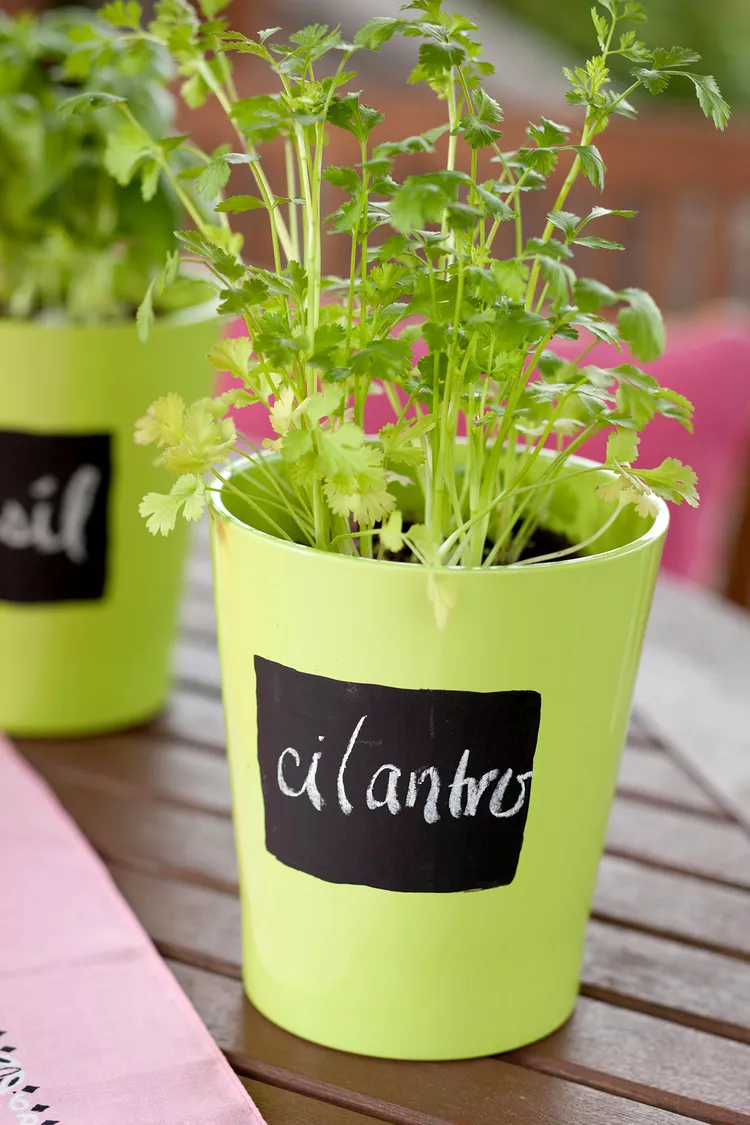Often used to flavor salsa, guacamole, and stir-fry dishes, cilantro is one herb many people can’t get enough of (unless genetics make the plant taste like soap). Outdoors, the plant grows best in cool weather. Cilantro can even tolerate a little frost but will die in freezing temperatures. To keep your supply going year-round, try growing cilantro indoors from seeds.
The plant is a bit finicky, but with the right amount of light, water, and other care, cilantro will grow well in a brightly lit area of your home. From seeding to harvesting, here’s how to grow cilantro indoors successfully.
What You'll Need
Equipment / Tools
- Sink or basin
- Drill (optional)
- Grow light (optional)
- Humidifier or tray with rocks
- Mister
- Scissors
Materials
- Cilantro seeds (coriander)
- Container with good drainage
- Vegetable and herb potting mix
- Plastic wrap
- Water-soluble fertilizer
Instructions
How to Grow Cilantro Indoors from Seed
Cilantro (Coriandrum sativum) is a fast-growing, cool-season annual herb that can go from seed to harvest in about three weeks. It usually sets seeds (which are known as coriander) in about a month and a half. Plan to sow new seeds every 2 or 3 weeks to keep up your supply of fresh cilantro leaves.
-
Use a Container with Drainage Holes
Like most herbs, cilantro doesn’t like "wet feet" (in other words, if its roots stay too wet, the plant will rot). So, when planning how to grow cilantro, choose a container with holes in the bottom for good drainage. Containers with drainage holes also allow for bottom watering. For this technique, you set the whole container into a sink or other basin filled with a few inches of water and allow the roots to reach the water they need while keeping the upper part of the plant dry.
Test Garden Tip
If you find a container for growing cilantro but it doesn’t have drainage holes, use a drill to create one to three drainage holes in the bottom of the pot.
-
Choose the Right Potting Mix
The potting mix you use is one of the keys to how to grow cilantro and other herbs. It’s best to use a potting mix labeled for indoor vegetable and herb growing, like a compost-and-vermiculite blend. It will have the right balance of ingredients to allow it not to be too soggy while still holding enough moisture for roots.
-
Sow Cilantro Seeds
Sow three to five cilantro seeds into your container’s potting mix about one to three times deeper than the size of the seed. When the seedlings are one to two inches tall, remove all but the most robust seedling.
-
Water and Cover
Water seeds lightly to help settle the potting mix around them. Cover the top of the container with plastic wrap. This will help keep the soil mix evenly moist to encourage germination. When the seedlings start to pop through the soil, remove the plastic wrap.
-
Place in a Sunny Spot
Cilantro plants need at least five hours of light per day. If your window location doesn't offer enough sunlight, you can supplement natural lighting with a grow light. For every hour of required sunlight, place the plant under a grow light for two hours. Be sure to rotate the pot every three to four days for uniform growth.
-
Add Fertilizer
About once a week, give young seedlings a diluted water-soluble fertilizer to fuel their speedy growth. Too much fertilizer can burn young plants, so don't be tempted to go overboard.
-
Make a Humid Environment
Especially in the winter, when the air tends to be drier, cilantro plants benefit from extra humidity. You can either use a humidifier or boost humidity around your plants in a more passive way.
For the latter solution, fill a tray with a layer of small rocks, then add water up to about ¼ inch of the top of the rocks. Set pots on top of the rocks, making sure the pots don’t touch the water. As the water evaporates into the air, the humidity level will increase. You also can mist the plants a few times each day.
-
Harvest Leaves
Around 30 days after planting cilantro seeds, the plant’s leaves will be ready for harvesting. You can either cut the whole plant to use in a recipe (cilantro pesto, anyone?), or snip off a few leaves to use as a garnish.
How To Cut Cilantro Without Killing the Plant
The best way to harvest cilantro so the plant keeps growing is to use scissors to snip off whole stems next to the base of the plant. Harvest the outside stems first, which are the oldest stems. This leaves younger stems to continue developing.
It’s important that you harvest no more than 30 percent of a single plant at a time. Waiting at least seven days between large harvests will help the plant to replenish itself. If your plant gets leggy and weak, remove the top of an entire stem just above a node (the joint where the leaves meet the stem). This will encourage fresh, compact new growth.




















